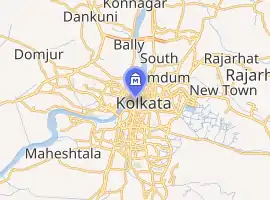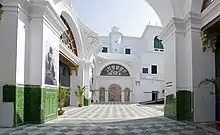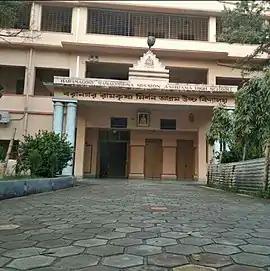Currency Building
The Currency Building is an early 19th-century building in the B. B. D. Bagh (Dalhousie Square) central business district of Kolkata in West Bengal, India. The Currency Building was originally built in 1833 to house the Calcutta branch of the Agra Bank. In 1868, the building was converted for the use of the British Raj imperial government Currency Department's Office of the Issue and Exchange of Government Currency. The Reserve Bank of India later used the building as its first office from 1935 until 1937. The building remained in operation until 1994, when authorities decided to demolish the building. The Central Public Works Department undertook demolition of the building from 1996 to 1998, when the Currency Building was saved from demolition by the Indian National Trust for Art and Cultural Heritage (INTACH) and the Kolkata Municipal Corporation. Custodianship passed to the Archaeological Survey of India (ASI) in 2003 and the survey commenced restoration of the building after taking possession of the building in 2005. The renovation of the Currency Building was completed in 2019, and it was formally reopened as a museum and dedicated to the nation by Prime Minister of India Narendra Modi on 11 January 2020.
 Currency Building, viewed from B. B. D. Bagh (Dalhousie Square) | |

| |
Former name | Agra Bank Agra and Masterman's Bank Currency Office Reserve Bank of India Old Currency Building |
|---|---|
| Established | 1833 (built) 1868 (Currency Office conversion) 2020 (post-renovation dedication) |
| Location | Old Court House Road and R. N. Mukherjee Road, Lal Dighi, B. B. D. Bagh (Dalhousie Square), Kolkata, West Bengal, India |
| Coordinates | 22.575663°N 88.352303°E |
| Type | Museum |
| Curator | DAG Museums National Gallery of Modern Art (NGMA) |
| Public transit access | Line 1 Line 2 Line 3 Esplanade metro station, Kolkata Metro |
Geography and setting
The Currency Building is located at 11B on B. B. D. Bagh, formerly known as Dalhousie Square, at the intersection of Old Court House Road and R. N. Mukherjee Road in the B. B. D. Bagh central business district of Kolkata in West Bengal, India.[1][2] The building's main façade faces west toward B. B. D. Bagh.[1][3] The Lal Dighi water tank is located approximately 100 metres (330 ft) to the building’s northwest, and the Esplanade metro station of the Kolkata Metro is located immediately west of the building.[1] The Hooghly River is located approximately 660 metres (2,170 ft) to the west of the Currency Building.[1]
History
Agra Bank
The plot on which the Currency Building now stands was originally the site of the Calcutta Auction Company's office building until 1825, when the Agra Bank[lower-alpha 1] acquired the plot.[9] The Agra Bank constructed the present-day Currency Building on this site in 1833 to house its Calcutta branch, during the tenure of Lord William Bentinck, Governor-General of India.[10][11][12] The Agra Bank ceased operation in 1866.[lower-alpha 2]
Currency Office

In 1868, the Currency Department of the British Raj imperial government converted a large portion of the building for use by the Office of the Issue and Exchange of Government Currency, after which, it became known as the Currency Building.[10][11][12] Between 1889 and 1890, the Administration of Bengal improved the building's drainage as part of its maintenance of Calcutta's civil buildings.[14] The Calcutta Mint sent silver coins to the Currency Office, where a working reserve of currency was stored, while the bulk of India's silver was then sent to Fort William.[15][16] The Currency Building later served as the first office of the Reserve Bank of India (RBI) from 1935 until 1937,[12][17][18] when the RBI relocated to Mumbai.[18] While the building remained in use, it suffered neglect, and at one point, the Currency Building was used by the Central Public Works Department (CPWD) as a storehouse.[17] The structure ceased operational use in 1994.[3][11]
Renovation
In 1994, authorities decided to raze the Currency Building due to its structural deterioration,[11] and custodianship passed to the CPWD, who planned to build a high-rise building in its place.[3][12][19] In 1996, the CPWD commenced the building's demolition.[11] The department successfully demolished the building's three large domes over the central hall before the Indian National Trust for Art and Cultural Heritage (INTACH) and the Kolkata Municipal Corporation intervened and halted the demolition project in 1998.[3][11][12] Custodianship passed to the Archaeological Survey of India (ASI) in 2003 and they took possession of the building in 2005.[3][11][12] ASI was entrusted with the Currency Building's conservation and restoration.[3][11][12] ASI took two years to remove piles of debris from the demolition, and then commenced the building's restoration by repairing and reconstructing the demolished portion around the Currency Building's central hall.[12] ASI's restoration project was led by a technical team of engineers and archaeologists.[12] However, the project was delayed due to a shortage in skilled workers with experience in lime plastering.[12]
Museum

The renovation of the Currency Building was completed in 2019, and on 11 January 2020, Prime Minister of India Narendra Modi formally dedicated the building as a museum to the nation at its reopening ceremony.[11] The Currency Building was one of four restored colonial buildings in Kolkata, along with Metcalfe Hall, Belvedere House, and the Victoria Memorial, to be dedicated by Modi.[19][20][21] The Currency Building’s reopening was marked by its inaugural art exhibition, "Ghare Baire | The World, The Home and Beyond: 18th-20th Century Art in Bengal" which opened on 12 January 2020.[2][11] The Ghare Baire exhibition was commissioned by India's Ministry of Culture, and it was curated and organised by DAG Museums, in collaboration with the National Gallery of Modern Art (NGMA).[2][11] According to DAG, a private art curation and education organisation, the Ghare Baire exhibition was "the first comprehensive showcasing of the art and artists of Bengal."[2] The exhibition was briefly closed due to the Coronavirus disease 2019 (COVID-19) pandemic.[11]
Architecture

The Currency Building is a three-story brick structure, built in the Italianate style of architecture.[10][16] The building's roof is arched by iron joists.[10][17] Its floors are covered by marble and Chunar sandstone.[10][17] The building’s main entrance on its western façade features a three-part gate made of wrought iron,[10] and Venetian windows.[17] [19][21] The Currency Building's central hall, now an open-air courtyard, was formerly topped by three large domes with skylights.[10][15] During the building's use as a currency office, the central hall contained the exchange counters for banknotes, gold, silver, and small change.[15][16] The building's second floor contained large, elaborately-finished rooms with Italian marble floors.[16] The building's third floor also featured Italian marble floors, and housed the residence of the Assistant Commissioner in-charge of the Currency Office.[10][16]
During the renovation of the Currency Building, the initial plan was to construct a glass roof over the central hall where the three domes were formerly located; however, ASI cancelled this plan and reorganized the central hall into a space for open-air programmes.[3] ASI installed sensor glass doors to provide access between the central hall and adjacent interior corridors,[3][21] and the organisation polished the doors and windows of the western wing and repainted the exterior façade white.[3] ASI lime plastered the interior walls, repaired floors, and restored decaying wooden staircases.[12][21] ASI overhauled the Currency Building's drainage system to mitigate seepage from the drainage lines of adjacent buildings.[12][21] During this project, ASI archaeologists uncovered evidence of an underground canal from the nearby Hooghly River, the water from which was to cool newly-minted coins.[17]
References
Explanatory notes
- The Agra Bank was established in 1833.[4] The Agra Bank became the Agra and United Service Bank, Limited, in 1862, and it subsequently merged with Masterman, Peters, Mildred, Birkbeck and Company, in 1864, and became the Agra and Masterman's Bank, Limited.[5][6] Agra and Masterman's Bank ceased operation in June 1866,[6][7] and in December 1866, all "property and effects" of the bank were transferred to Agra Bank, Limited,[7][8] which was reincorporated in 1867.[6] Agra Bank, Limited, continued operation until its liquidation in 1900.[6]
- While sources differ on the year of the Agra Bank's failure (1866 or 1886) and on the year of the Currency Department's acquisition of the Currency Building (1868, 1886, or 1888), the Reserve Bank of India, the Court of Chancery, and statistician John Biddulph Martin state that the Agra Bank failed in 1866.[4][7][13] The Currency Department took over the building shortly after the failure of the Agra Bank, which makes 1868 the more likely year for the building's acquisition by the department.
Citations
- "Map centered on the Currency Building". Google Maps. 2020. Archived from the original on 19 December 2020. Retrieved 19 December 2020.
- "Ghare Baire". DAG website. DAG. 2020. Archived from the original on 27 October 2020. Retrieved 19 December 2020.
- Roy, Subhajoy (5 January 2019). "Currency Building, a Calcutta heritage, turns into an exhibition hub". The Telegraph. Kolkata. Archived from the original on 19 December 2020. Retrieved 19 December 2020.
- "Museum: The Advent of Modern Banking in India, 1720 to 1850s". Reserve Bank of India website. Reserve Bank of India. 2020. Archived from the original on 31 December 2020. Retrieved 22 December 2020.
- Mäkitie 2016, p. 36.
- Jones 1995, p. 403.
- Hemming 1870, p. 730.
- "No. 23192". The London Gazette. 30 November 1866. p. 6695.
- Chaudhuri, Drimi (31 May 2015). "Restoring glory of Currency Building". Deccan Chronicle. Hyderabad. Archived from the original on 31 December 2020. Retrieved 22 December 2020.
- "Monuments". Archaeological Survey of India, Kolkata Circle website. Archaeological Survey of India, Kolkata Circle. 2020. Archived from the original on 18 September 2020. Retrieved 19 December 2020.
- Ghosh, Bishwanath (14 December 2020). "1833 building that escaped demolition is now a goldmine of art". The Hindu. Chennai. Archived from the original on 19 December 2020. Retrieved 19 December 2020.
- "ASI steps to restore 200-year-old Currency building in Dalhousie". The Economic Times. Mumbai. 20 February 2015. Retrieved 19 December 2020.
- Martin 1879, p. 678.
- Administration of Bengal 1890, pp. 207–208.
- Suhrawardy 1936, p. 74.
- Cotton 1980, p. 744.
- Singh, Shiv Sahay (11 February 2015). "Restoring value to the Currency Building". The Hindu. Chennai. Archived from the original on 7 May 2020. Retrieved 19 December 2020.
- "Kolkata Regional Office of the Reserve Bank of India Profile". Reserve Bank of India website. Reserve Bank of India. 2020. Archived from the original on 19 December 2020. Retrieved 19 December 2020.
- Times Travel Editor (11 February 2015). "3 colonial structures restored in Kolkata; PM to do the re-dedication". The Times of India. Mumbai. Archived from the original on 18 September 2020. Retrieved 19 December 2020.
- Press Information Bureau (11 January 2020). "Prime Minister Dedicates Four Refurbished Heritage Buildings in Kolkata to the Nation" (Press release). Delhi: Press Information Bureau. Ministry of Culture. Archived from the original on 19 December 2020. Retrieved 19 December 2020.
- Madhukalya, Amrita (11 January 2020). "PM Modi to begin two-day visit to Kolkata, inaugurate 4 revamped buildings". Hindustan Times. New Delhi. Archived from the original on 16 January 2020. Retrieved 19 December 2020.
Bibliography
- Administration of Bengal (1890). Report of the Administration of Bengal, 1889–90. Calcutta: The Bengal Secretariat Press – via Internet Archive.
- Cotton, H. E. A. (1980). Ray, N. A. (ed.). Calcutta Old and New: A Historical and Descriptive Handbook to the City. Calcutta: B. Sinha – via Internet Archive.
- Hemming, G. W., ed. (1870). The Law Reports: Equity Cases, Including Bankruptcy Cases, Before The Master of the Rolls, the Vice-Chancellors, and the Chief Judge in Bankruptcy. IX. London: William Clowes and Sons, Printed for the Council of Law Reporting. Archived from the original on 31 December 2020. Retrieved 31 December 2020 – via Google Books.
- Jones, Geoffrey (1995). British Multinational Banking, 1830-1990. Oxford: Clarendon Press. ISBN 9780198206026. Archived from the original on 31 December 2020. Retrieved 31 December 2020 – via Google Books.
- Mäkitie, Ilkka (July 2016). "British Circular Notes – a listing with illustrations". International Bank Note Society Journal. 55 (3): 30–38. Retrieved 24 December 2020 – via Internet Archive.
- Martin, John Biddulph (September 1879). "On Some Effects of a Crisis on the Banking Interest". Journal of the Statistical Society of London. 42 (3): 663–708. doi:10.2307/2339053. JSTOR 2339053. Archived from the original on 31 December 2020. Retrieved 24 December 2020 – via JSTOR.
- Suhrawardy, Hassan (1936). Calcutta and Environs. Calcutta – via Internet Archive.
External links
 Media related to Currency Building, Kolkata at Wikimedia Commons
Media related to Currency Building, Kolkata at Wikimedia Commons
